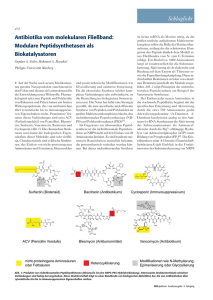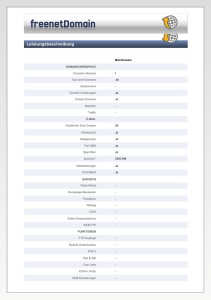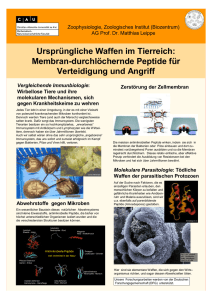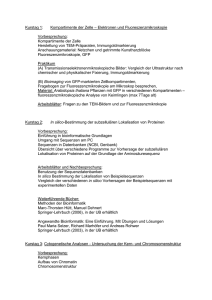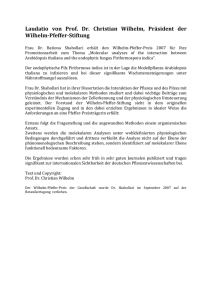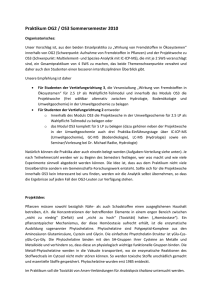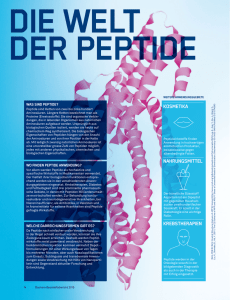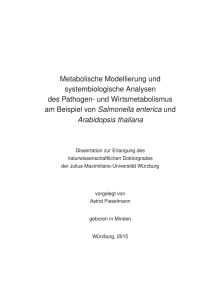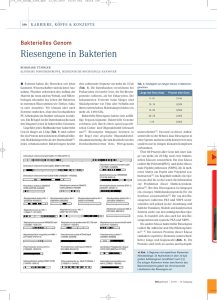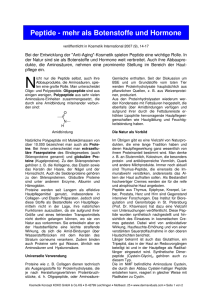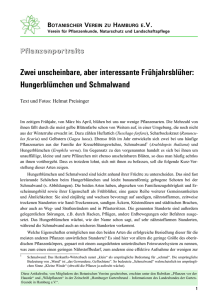Structural characterization of Arabidopsis thaliana ethylene
Werbung
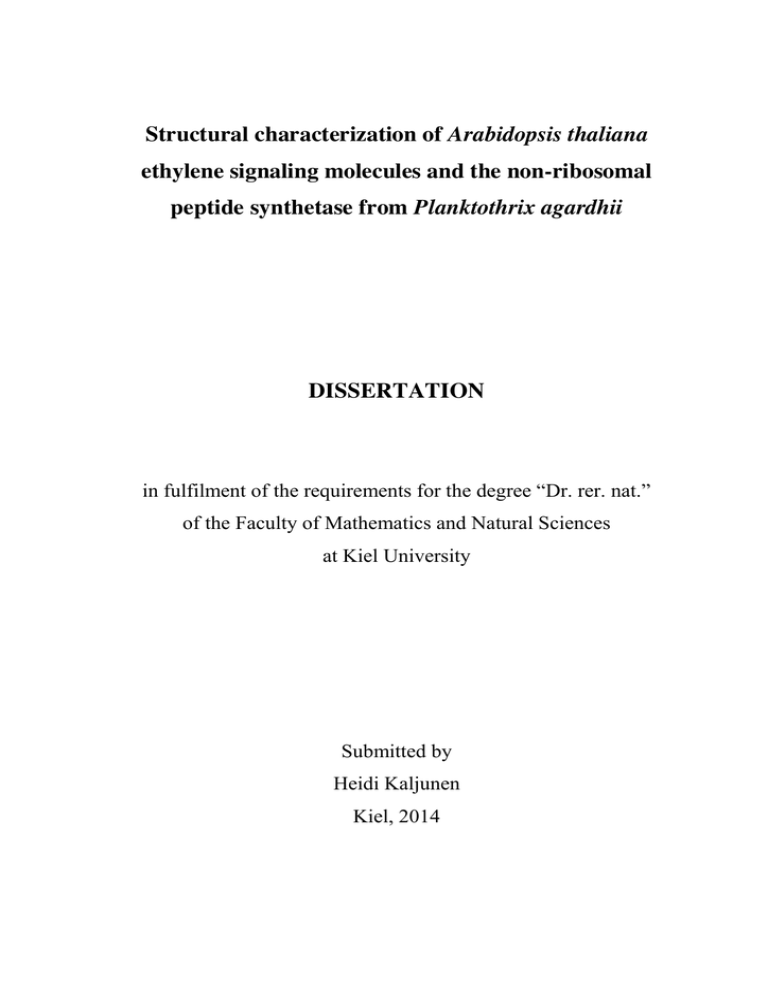
Structural characterization of Arabidopsis thaliana ethylene signaling molecules and the non-ribosomal peptide synthetase from Planktothrix agardhii DISSERTATION in fulfilment of the requirements for the degree “Dr. rer. nat.” of the Faculty of Mathematics and Natural Sciences at Kiel University Submitted by Heidi Kaljunen Kiel, 2014 First referee: Prof. Dr. Axel J. Scheidig Second referee: Prof. Dr. Frank Sönnichsen Date of the oral examination: 12.12.2014 Approved for publication: 12.12.2014 Signed: Prof. Dr. Wolfgang J. Duschl, Dean 2 ZUSAMMENFASSUNG Pflanzen nutzen ein komplexes Signalweiterleitungsnetzwerk zur Regulierung von Entwicklungsprozessen und zur Reaktion auf umweltbedingte und biologische Belastungen. Ethylen ist ein Schlüsselhormon in der Kontrolle dieses Netzwerks, weshalb es zusammen mit seinem Signalweg Objekt jahrzehntelanger intensiver Untersuchungen wurde. Im Modellsystem Arabidopsis thaliana wird das Hormon von einer Gruppe aus fünf Rezeptoren (ETR1, ERS1, ETR2, ERS2 und EIN4) erkannt, die den Sensorhistidinkinasen bakterieller zwei-komponenten Systeme ähneln. Hauptziel dieser Arbeit war die Expression und Reinigung des gesamten ETR1 zur strukturellen Untersuchung, um einen Einblick in die ersten Schritte der Ethylensignalisierung zu erhalten. Der vollständige ETR1 wurde erfolgreich im Baculovirussystem exprimiert, die Isolation des Rezeptors aus der Membran gelang allerdings nicht. Zuätzlich zum vollständigen ETR1 wurde die zytosolische Domäne des Rezeptors mit Hilfe der Kleinwinkelstreuung untersucht. Das entsprechende SAXS Modell war wie erwartet ein Dimer. EDR1 aus A. thaliana ist eine CTR1- ähnliche MAPKKK, die Resistenzen, Zelltod und ethyleninduzierte Seneszenz reguliert. Es besteht aus einer N-terminalen Regulationsdomäne und einer katalytischen C-terminalen Domäne mit Ser/Thr Kinaseaktivität. Da gezeigt wurde, dass EDR1 trans autophosphoryliert, sollte dieser Mechanismus röntgenkristallographisch untersucht werden. Die Kristallstruktur der katalytischen Domäne von EDR1 (EDR1-D792N) zusammen mit dem ATP-Analogon AMPPNP wurde gelöst. Die asymmetrische Einheit enthält 2 Moleküle, wovon eines überraschenderweise in der aktiven Konformation vorlag. Außerdem formt das aktive EDR1D792N einen trans-autophosphorylierenden Komplex mit dem inaktiven Monomer einer benachbarten asymmetrischen Einheit. Zusätzlich zum pflanzlichen Abwehrmechanismus wurde die Adenylierungsdomäne der cyanobakteriellen nicht-ribosomalen Peptidsynthetase (non-ribosomal peptide synthetase, NRPS) untersucht. NRPS sind große Multidomänenenzyme, die in einer Reihe von Pilzen und bakterieller Spezies vorkommen und den ribosomenunabhängigen Aufbau biologisch aktiver Peptide unterschiedlicher Zusammensetzung und Funktion katalysieren. Die A-Domäne spielt eine zentrale Rolle in den NRPS, da sie die Aminosäure erkennt und aktiviert, die in das wachsende Peptid eingebaut wird. Die A-Domäne ApnA A1 aus Planktothrix agardhii der Anabaenopeptinsynthetase is ein aufschlussreicher Vertreter seiner Klasse, da es die außergewöhnliche Fähigkeit besitzt zwei sehr unterschiedliche Aminosäuren (Arginin und Tyrosin) zu aktivieren. Strukturelle Untersuchungen zur Klärung der doppelten Spezifität wurden durchgeführt. Basierend auf Strukturen der ApnA A1 wurden 2 Reste des aktiven Zentrums identifiziert, die eine zentrale Rolle bei der Substratbindung spielen. Mutation dieser Reste resultierte in Enzymvarianten, die entweder für Tyrosin oder Arginin mono-spezifisch waren, oder in einigen Fällen in der Lage waren LTryptophan zu aktivieren. Außerdem konnten einige ApnA A1 Mutanten unnatürliche Aminosäuren (4-Fluorophenylalanin und 4-Azidophenylalanin) aktivieren. Ein Peptidprodukt mit einer eingebauten unnatürliche Aminosäuren könnte für industrielle oder pharmazeutische Anwendungen nützlich sein. ABSTRACT Plants employ a complex network of signaling pathways to regulate developmental processes and to mediate the responses to both environmental and biological stress factors. Ethylene is one of the key plant hormones involved in controlling this network, which has made it and its signaling pathway a target of intense research for several decades. In the model plant Arabidopsis thaliana, the plant hormone is detected by a group of five receptors (ETR1, ERS1, ETR2, ERS2 and EIN4) that resemble the sensor histidine kinases of bacterial two-component system. The main aim in this thesis study was the expression and purification of the full-length ETR1 for structural studies to gain insights into the initial steps in ethylene signaling. The FL ETR1 was successfully expressed in baculovirus expression vector system but the isolation of the receptor from the membrane was hampered. In addition to the FL ETR1, the cytosolic portion of the receptor was studied using Small Angle X-ray Scattering. The resulting SAXS model had the expected dimeric arrangement. EDR1 from A. thaliana is a CTR1-like MAPKKK that is involved in regulating disease resistance responses, cell death and also ethylene-induced senescence. It possesses an N-terminal regulatory domain and C-terminal catalytic domain wit Ser/Thr kinase activity. As EDR1 has been shown to autophosphorylate in trans, the mechanism of this was studied using X-ray crystallography. A crystal structure for the catalytically inactive kinase domain of EDR1 (EDR1D792N) was obtained in the presence of the ATP substrate analog AMP-PNP. The asymmetric unit contained two molecules, one of which surprisingly was in an active-like conformation. Furthermore, the active-like EDR1-D792N molecule was found to form an authentic transautophosphorylation complex with the inactive monomer from the adjacent asymmetric unit. In addition to the plant defense signaling proteins, an adenylation (A) domain from cyanobacterial non-ribosomal peptide synthetase (NRPS) was studied. NRPSs are large multidomain enzymes that are found from a number of fungal and bacterial species and catalyze the ribosome-independent assembly of biologically active peptides with diverse composition and function. The A domain plays a central role in the NRPS system as it recognizes and activates the amino acid, which is incorporated into the growing peptide. The A domain ApnA A1 from the Anabaenopeptin synthetase of Planktothrix agardhii is an interesting member of its class as it has an unusual ability to activate two very distinct amino acids (arginine and tyrosine). Structural studies on this enzyme were performed to elucidate its bi-specificity. Based on the solved ApnA A1 structures, two active site residues with a crucial role in the substrate binding were identified. The mutation of these residues led to enzyme variants, which were mono-specific for either tyrosine or arginine, or in some instances were able to activate L-tryptophan. Additionally a number of ApnA A1 mutants were shown to activate unnatural amino acids (4-fluorophenylalanine and 4azidophenylalanine). A final peptide product with an unnatural amino acid incorporated, could possibly have useful industrial or pharmaceutical applications.
